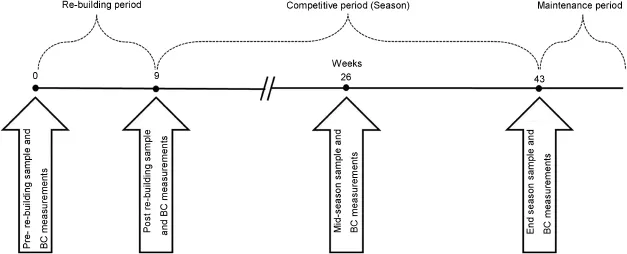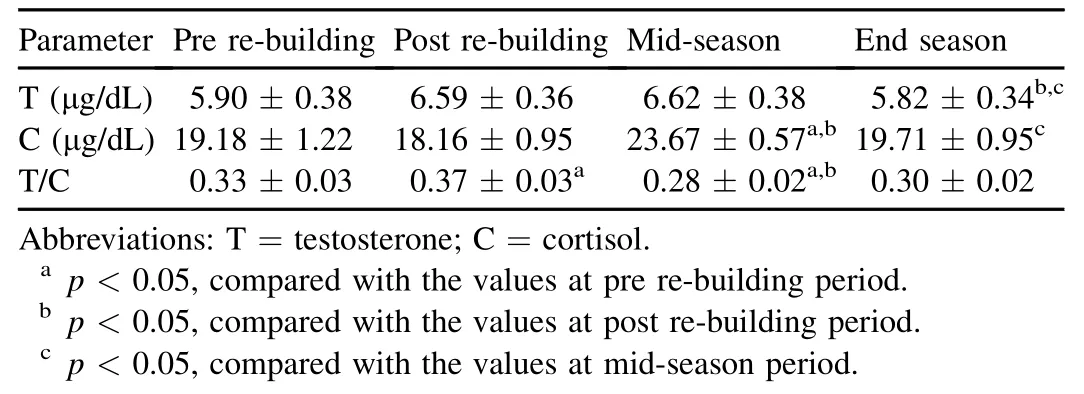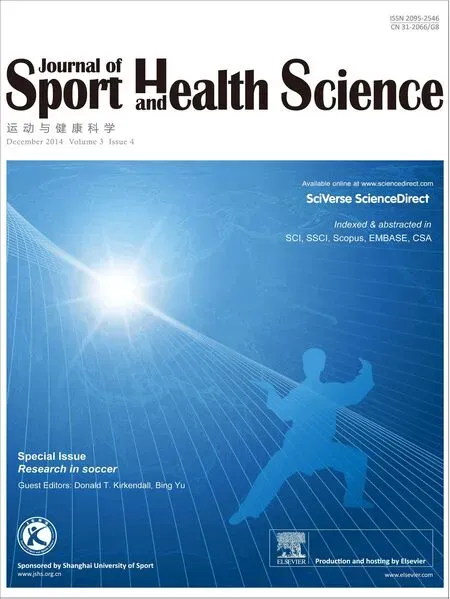Stress hormonal analysis in elite soccer players during a season
Yiannis M ichailidis
Department of Physical Education and Sport Sciences,Democritus University of Thrace,Komotini,69100,Greece
Stress hormonal analysis in elite soccer players during a season
Yiannis M ichailidis
Department of Physical Education and Sport Sciences,Democritus University of Thrace,Komotini,69100,Greece
Purpose:The purpose of this study was to evaluate the changes in some hormonalparameters(cortisol,testosterone,ratio of testosterone/cortisol (T/C))in professional soccer players during a season.
Cortisol;Ratio testosterone/cortisol;Soccer;Testosterone
1.Introduction
Two very important hormones in the biochemical assessmentof athletes are testosterone and cortisol.Testosterone is a steroid hormone that is the most potent naturally-occurring androgen,and regulates the development of the male reproductive system and secondary sex characteristics.Testosterone is produced mainly in the testes.1Cortisol is a principalsteroid hormone produced by the adrenal cortex.It regulates carbohydrate metabolism and the immune system,and promotes gluconeogenesis,glycogen synthesis,and protein synthesis in the liver.1Cortisol belongs to the group of glucocorticoid hormones,and testosterone to the androgen family.A high cortisol concentration may cause inhibition of the immune system and proteolysis,and for this reason it is related to the control of catabolic processes in the body.2Testosterone has anabolic effects in the body,and thus ithas been related to the control of anabolic state.
Exercise has been used in many studies as a stress factor to activate various body systems like the endocrine system.3It has been reported in the literature that plasma cortisol increased after acute exercise which exceeded 60%of the VO2max,and also after intense resistance exercise.2,4Systematic training has resulted in higher concentrations of cortisolat rest as compared to non-exercisers.This measurement of cortisol can be used as an indicator of physical stress.
Ifone wanted to increase the concentration of testosterone,the exercise intensity and duration should be increased.3,5,6The effect of regular exercise on the concentrations of testosterone is less clear,but also in this case,the intensity and duration play a significant role.In some cases,runners had lower rest values of testosterone than non-athletes.1Testosterone promotes protein synthesis7—9and therefore is used as an indicator of anabolic processes in the body.However,ithas been reported thatduring exhaustiveexercise,theconcentration ofthishormonedecreases.10
Another parameter used to evaluate athletes is the resting ratio of testosterone/cortisol(T/C).This ratio has beenassociated w ith overtraining syndrome.In this syndrome,an accumulation of training and/or non-training stress results in a long-term decrement in performance capacity w ith or w ithout related physiologicaland psychologicalsigns and symptoms of maladaptation,in which the restoration of the performance capacity may take severalweeks ormonths.11,12There are studies thatindicate overtraining athletesto thisdecreased T/C ratio was associated w ith increased proteolysis and decreased protein synthesis.13,14However,there are studies that found no correlation between this ratio and overtraining syndrome.15—17Despite the controversial role of this ratio,regular measurement is an indicator of the balance between catabolic and anabolic processes,13,14,18and suggests possible changes required in the training program of the athlete.
Soccer at a high level is a demanding sport.Apart from technique and tactics know ledge,the participants should also be sufficiently developed in all physical abilities.The training season in soccer lasts about 11 months.Approximately 2 months are the preparation period,8 months represents the competitive season,1 month is a transitional period and 1 month is the players’holiday.In the re-building period,the players try to improve theirphysicalabilities.In the nextphase (in season),they have to maintain these abilities at the highest level.To improve through training,the process should be a proper balance between the volume and intensity of training w ith rest periods.19A long recovery from training may not lead to optimal adjustments whereas limited recovery for a long time w illprobably lead to overtraining syndrome w ith all of its negative effects on the player’s performance and health.18—20Furthermore,the psychologicalstress thata player experiences during the season is an additional factor that can influence his physiological state.One way to protect the players is to regularly monitor the concentrations of testosterone and cortisol and their ratio during the course of the season.21—25
The aim of this study was to analyze the testosterone and cortisol responses in a professional soccer team that participates in a professionalGreek league throughout the season.To our know ledge,this research is the only study performed in professional soccer players over an entire season.
2.M ethods
2.1.Experimental approach
We studied the changes in testosterone,cortisol,and their ratio throughout a soccer season.In this way,we studied the stresses provoked by exercise through a season of competition in professional players.The team participated in 30 matches for the championship,and five matches for the cup.Samples were collected before the beginning of the re-building period, just after the re-building period,at the m iddle of the season, and at the end of the season(Fig.1).The samples were collected 24 h after different matches,at 8:00 am,in the fasting state.The blood samples were collected at rest.The measurements were assessed as part of the standard anthropometric/physical conditioning testing.
2.2.Subjects
At the beginning of the study,25 male professional soccer players were enrolled.During the season,some of them were injured and lost some training sessions.In total,15 players participated in the study who followed the team program w ithout having any serious injuries.A ll of the players had participated for at least 3 years in the fi rst division of the Greek league.On average,the players trained 6—7 times per week and participated in a match every week.
After receiving a detailed explanation of the study’s benefi ts and risks,each subject signed an informed consent document that was approved by the local ethics comm ittee.
2.3.Anthropometrics
Body mass was measured to the nearest 0.1 kg(BC-418 Segmental Body Composition Analyzer,Tanita,Japan)w ith the subjects wearing their underclothes and barefoot.The body fat percentage was calculated from seven skinfold measurements(average of two measurements from each site)using a Harpenden calliper(John Bull,British Indicators,St Albans, UK)on the rightside of the body as described by Jackson andPollock.26Fat free mass values were obtained from the measurements of the estimated body fat and body mass.Standing height was measured to the nearest 0.1 cm(Stadiometer 208, Seca,Vogel Halke,Hamburg,Australia).

Fig.1.Procedure for the sampling and anthropometric measurements.BC=body composition.
2.4.Blood collection,testosterone,and cortisolmeasurements
Blood samples(8 m L)were collected via venipuncture from an antecubital arm vein using a safety butterfl y set w ith the participants always in a sem i-recumbent position.Blood was collected into Vacutainer tubes containing SST-Gel and Clot Activator.The blood was allowed to clot at room temperature,and subsequently centrifuged(1500g,4°C,15 m in) for serum separation.The resulting serum was used for the measurements.The samples were stored and frozen at-75°C until analyzed.Testosterone and cortisol were analyzed w ith assay kits from DRG diagnostics(DRG,International Inc., New York,USA;Research Use Only,Testosterone CLA-4660, Cortisol CLA-4651,New York,USA).The intra-and interassay coefficients of variation(CVs)for testosterone were 3.7%and 5.6%,respectively.The intra-and inter-assay CVs for cortisol were 4.0%and 5.7%,respectively.
2.5.General training program in each period
During the re-building period,the trainers were trying to improve the physical abilities of the players.The players also participated to six friendly games.Table 1 presents the general characteristics of the training session.
A general program for the competitive period is presented in Table 2.Until the 26th week,the team participated in 17 games and after this week,18 games.
The maintenance period was 6 weeks and the players participated in some kind ofexercise 2—3 times perweek.The fi rst 3 weeks they took part in some sports like sw imm ing, tennis,or basketball and the next 3 weeks they performed running,general strength and flexibility exercises,and individual soccer techniques.
2.6.Statistical analysis
A ll data are presented as mean±SEM.Data normality was verified w ith the One-sample Kolmogorov—Smirnov test; therefore,a nonparametric test was not necessary.The data were analyzed by a one-way repeated measures analysis of variance(ANOVA)to examine changes in the mean values of the hormones over the course of the soccer season.When a significant effect was found,apost hocBonferroni test was performed.The levelof significance was setatp<0.05.The data were analyzed using SPSS,PC program,version 13 (SPSS Inc.,IBM,Armonk,NY,USA).

?
3.Results
No significantdifferences were revealed by the ANOVA in the estimated body composition indicators.Table 3 presents the mean values of these variables.

Table 2 Program during the competitive period.
The statistical analyses for testosterone demonstrated differences(F(3,42)=4.267,p<0.05)between the measurements.The concentration of testosterone increased at the end of the re-building period(11.6%),and remained at the same level(12.1%)in the next measurement(m id-season).However,at the end of the season,the concentration of the hormone decreased to below the initial levels(-1.5%).A statistical difference was observed between the measurement at the end of the re-building period and at the m id-season w ith that at the end of the season(p<0.05)(Table 4).
Significant differences in the cortisol concentration were found by ANOVA(F(3,42)=7.782,p<0.001).The cortisol concentration decreased at the end of re-building period (-5.3%),then increased during mid-season(23.4%),and at the end of the season,the concentration reached the initial values(2.8%).The m id-season value of the hormone differed significantly from the fi rst two measurements(pre and post rebuilding period)(p<0.05).Furthermore,the measurementat the end of the season differed from that of the m id-season (p<0.05)(Table 4).
T/C ratio also showed significant changes along the season (F(3,42)=6.147,p=0.001).The initial value increased by 12.1%at the end of the re-building period(0.37±0.03).At the mid-season measurement,the ratio decreased by 15.2% compared w ith the initialmeasurement(p<0.05).Finally,atthe end of the season,the value of the ratio was 9.1%less than the fi rstmeasurement(Table 4).

Table 3 Variables of body composition at sample collecting time(mean±SEM).

Table 4 Hormone concentrations and their ratio value(means±SEM).
4.Discussion
It is important to note that the major aim of the team was to remain in this division.At the end of the season,the players had accomplished this purpose.
The secretion of cortisol is related to stress.As mentioned above,the exercise functioned as a stress factor,and the amount of hormone produced depends positively on the intensity and duration of exercise.27In this study,the largest change in the hormone was an increase of cortisol concentration(23.4%)in the m id-season.The increased concentration of cortisol in the m id-season in team sports has been reported by other researchers.28
When athletes follow a properly designed exercise program,the cortisol that is produced after each workout is removed from the body w ithin 24 h.Therefore,the changes in the concentration of cortisol may be associated w ith stress accumulated during the season.29In this study,according to the concentration of cortisol,the players experienced a time pointduring the season with intense stress.This measurement was at the middle of the season,where the matches,the training load,the psychological pressure to perform,and the difficulty of soccer pitches(the m id-season coinciding w ith the m iddle ofw inter)exhausted the players.Furthermore,after the end of the season when allof the above aggravating factors disappeared,the hormone levels decreased.
Testosterone as an anabolic hormone has been reported as an indicator of the rate of regeneration of the body,7,9and stress caused by training.22,23,30In this study,the concentration of testosterone after an intense re-building period was increased by 11.6%,and returned to baseline levels at the end of the season.These findings partly reflect the good management between the training load and the rest periods.It is also apparent that increased levels of this hormone are desirable for long seasons with intensive competition.The increase in the testosterone concentration during the season of team sports has been reported by other investigators.28
The T/C ratio has been reported as an indicator of the homeostasis between anabolic and catabolic processes in the body13,14and overtraining.31In the present study,the ratio increased after the re-building period by 12.1%,whereas the next measurement(m id-season)decreased by 24.3%,in comparison w ith post re-building period.These findings suggest that during the pre-season,the players were not tired and could respond adequately to the coaching w ithout accumulating fatigue.However,in the mid-season,the significant decline in this ratio is probably a result of the aggravating factors mentioned above,and led to the increased cortisol concentration.19A significant decrease in the ratio was also reported by Handziski et al.32after half of the soccer season. The end of the season resulted in a dramatic reduction in total stress related to the season,and restored the ratio to baseline. The fact that there was a decline in the ratio ofabout24%does not necessarily mean that the players were in an overtrainingstate,since for such a finding several other factors should be taken into account.31,33
If a player had overtraining symptoms,the trainers would have to protect him and prepare individualized training sessions.A playerw ith this problem has to abstain from vigorous exercises and games.It is better to“lose”a player for 2—3 weeks than for 3—4 months or more.34
In exercise,many hormones play a significant role.1In this study we investigate the changes of testosterone and cortisol in a complete soccer season.Soccer coaches and sport scientists have to observe regularly the changes of these hormones for improving players’performance.
5.Conclusion
The concentrations of these hormones and their ratio are an indicator of the functional status of an athlete,and should be measured during the soccer season so that the coaches can individualize the training as needed.For the measurement of these hormones to be useful,they should not be isolated but should be timed regularly so that the medical team can observe these changes.Proper cooperation between the medical team and the coaches w ill help to maxim ize the performance of the players,and lim it any cases of overtraining.
Acknow ledgm ent
The author thanks the soccer players for their cooperation.
1.Mougios V.Exercise biochemistry.Champaign,IL:Human Kinetics; 2006.
2.Brisswalter J,Collardeau M,Rene A.Effects of acute physical exercise characteristics on cognitive performance.Sports Med2002;32:555—66.
3.Tarpenning KM,W iswell RA,Hawkins SA,Marcell TJ.Infl uence of weight training exercise and modification of hormonal response on skeletal muscle grow th.J Sci Med Sport2001;4:431—46.
4.Brownlee K,Viru M,Viru A,Behr MB,Hackney AC.Exercise and the relationship between circulating cortisol and testosterone concentrations in men.Phy Educ Sport2006;50:30—3.
5.Galbo H,Hummer L,Petersen IB,Christensen NJ,Bie N.Thyroid and testicular hormone responses to graded and prolonged exercise in man.Eur J Appl Physiol Occup Physiol1977;36:101—6.
6.Tremblay MS,Copeland JL,Van Helder W.Effect of training status and exercise mode on endogenous steroid hormones in men.J Appl Physiol (1985)2004;96:531—9.
7.Kraemer WJ.Endocrine responses to resistance exercise.Med Sci Sports Exerc1988;20:S152—7.
8.Kraemer WJ,Deschenes MR,Fleck SJ.Physiological adaptations to resistance exercise.Implications for athletic conditioning.Sports Med1988;6:246—56.
9.Oltras CM,Mora F,Vives F.Beta endorphin and ACTH in plasma:effects of physical and psychological stress.Life Sci1987;40:1683—6.
10.Keizer H,Janssen GM,Menheere P,Kranenburg G.Changes in basal plasma testosterone,cortisol,and dehydroepiandrosterone sulfate in previously untrained males and females preparing for a marathon.Int J Sports Med1989;10(Suppl.3):S139—45.
11.Halson SL,Jeukendrup AE.Does overtraining exist?An analysis of overreaching and overtraining research.Sports Med2004;34:967—81.
12.Budgett R,Newsholme E,Lehmann M,Sharp C,Jones D,Peto T,et al. Redefining the overtraining syndrome as the unexplained underperformance syndrome.Br J Sports Med2000;34:67—8.
13.Vervoorn C,Quist AM,Vermulst LJ,Erich WB,de Vries WR, Thijssen JH.The behaviour of the plasma free testosterone/cortisol ratio during a season of elite row ing training.Int JSportsMed1991;12:257—63.
14.Viru AM,Hackney AC,Valja E,Karelson K,Janson T,Viru M.Influence of prolonged continuous exercise on hormonal responses to subsequent exercise in humans.Eur J Appl Physiol2001;85:578—85.
15.Duclos M.A critical assessmentof hormonalmethods used in monitoring training status in athletes.Int Sport Med J2008;9:56—66.
16.Lehmann M,Petersen KG,Liu Y,Gastmann U,Lormes W,Steinacker JM. Chronic,exhaustive exercise in sport.Influence of leptin and inhibin.Dtsch Z Sportmed2001;51:234—43[in Germany].
17.Urhausen A,Gabriel H,Kindermann W.Blood hormones as markers of training stress and overtraining.Sports Med1995;20:251—76.
18.Kraemer WJ,Ratamess NA.Hormonal responses and adaptations to resistance exercise and training.Sports Med2005;35:339—61.
19.Kuipers H,Keizer HA.Overtraining in elite athletes.Review and directions for the future.Sports Med1988;6:79—92.
20.AngeliA,M inetto M,Diovio A,PaccottiP.The overtraining syndrome in athletes:a stress related disorder.J Endocrinol Invest2004;27:603—12.
21.Banfi G,DolciA.Free testosterone/cortisol ratio in soccer:usefulnessofa categorization of values.J Sports Med Phys Fitness2006;46:611—6.
22.Hakkinen K,Pakarinen A,Alen M,Kauhanen H,Komi PV.Relationships between training volume,physical performance capacity and serum hormone concentrations during prolonged training in elite weight lifters.Int J Sports Med1987;8:61—5.
23.Hakkinen K,Pakarinen A,A len M,Kom i PV.Serum hormones during prolonged training of neuromuscular performance.Eur J Appl Physiol Occup Physiol1985;53:287—93.
24.Passelergue P,Lac G.Saliva cortisol,testosterone and T/C ratio variations during a w restling competition and during the post competitive recovery period.Int J Sports Med1999;20:109—13.
25.Mujica I,Chatard JC,Padilla S,Guezennec CY,Geyssant A.Hormonal responses to training and its tapering off in competitive swimmers:relationships w ith performance.Eur J Appl Physiol Occup Physiol1996;74:361—6.
26.Jackson AS,Pollock ML.Generalized equations for predicting body density of men.Br J Nutr1978;40:497—504.
27.Galbo H.Hormonal and metabolic adaptations to exercise.New York: Georg Thieme Verlag;1983.
28.Martinez AC,Seco Calvo J,Tur Mari JA,Abecia Inchaurregui LC, Orella EE,Biescas AP.Testosterone and cortisol changes in professional basketball players through a season competition.J Strength Cond Res2010;24:1102—8.
29.Engelmann M,LandgrafR,Wotjak CT.The hypothalamic-neurohypophysial system regulates the hypothalam ic-pituitary-adrenalaxisunderstress:an old concept revisited.FrontNeuroendocrinol2004;25:132—49.
30.Adlercreutz H,Harkonen M,Kuoppasalm i K,Na¨veri H,Huhtaniem i I, Tikkanen H,etal.Effect training on plasma anabolic and catabolic steroid hormones and their responses during physical exercise.Int J Sports Med1986;7:27—8.
31.Urhausen A,Kindermann W.Diagnosis of overtraining:what tools do we have?Sports Med2002;32:95—102.
32.Handziski Z,Maleska V,Petrovska S,Nikolik S,M ickoska E,Dalip M, et al.The changes of ACTH,cortisol,testosterone and testosterone/ cortisol ratio in professional soccer players during a competition halfseason.Bratisl Lek Listy2006;107:259—63.
33.Hoffman JR,Epstein S,Yarom Y,Zigel L,Einbinder M.Hormonal and biochem ical changes in elite basketball players during a 4-week training camp.J Strenght Cond Res1999;13:280—5.
34.Meeusen R,Duclos M,Foster C,Fry A,Gleeson M,Nieman D,et al. Prevention,diagnosis and treatment of the overtraining syndrome:joint consensus statement of the European College of Sport Science and the American College of Sports Medicine.MedSci Sports Exerc2013;45:186—205.
Received 22 October 2013;revised 5 December 2013;accepted 11 March 2014 Available online 14 July 2014
E-mail address:michailidis79@hotmail.com
Peer review under responsibility of Shanghai University of Sport.
2095-2546/$-see front matter CopyrightⒸ2014,Shanghai University of Sport.Production and hosting by Elsevier B.V.A ll rights reserved. http://dx.doi.org/10.1016/j.jshs.2014.03.016
Methods:Fifteen professional players from a soccer club of the fi rst division of the Greek soccer league participated.A ll sport medical examinations were conducted four times:before the re-building period,post re-building period,m id-season,and after finishing the competition phase. Results:For testosterone,significantdifferences were observed between the end season and post re-building period(11.6%;p<0.05)and m idseason(12.1%;p<0.05).The cortisol concentration increased atm id-season by approximately 23%,and this change differed significantly from all other measurements for this hormone.The T/C ratio increased at the post re-building period and decreased at the m iddle of the season. Conclusion:These hormones and their ratios could be used as stress and recovery state indicators.Coaches can use these parameters in combination w ith other indicators to optim ize workloads,and to avoid overreaching and overtraining.
CopyrightⒸ2014,Shanghai University of Sport.Production and hosting by Elsevier B.V.All rights reserved.
 Journal of Sport and Health Science2014年4期
Journal of Sport and Health Science2014年4期
- Journal of Sport and Health Science的其它文章
- Principles and practices of training for soccer
- Women’s football:Player characteristics and demands of the game
- The relative age effect has no influence on match outcome in youth soccer
- Effects of small-volume soccer and vibration training on body composition,aerobic fi tness,and muscular PCr kinetics for inactive women aged 20—45
- The acute effects of vibration stimulus follow ing FIFA 11+on agility and reactive strength in collegiate soccer players
- Concussion management in soccer
